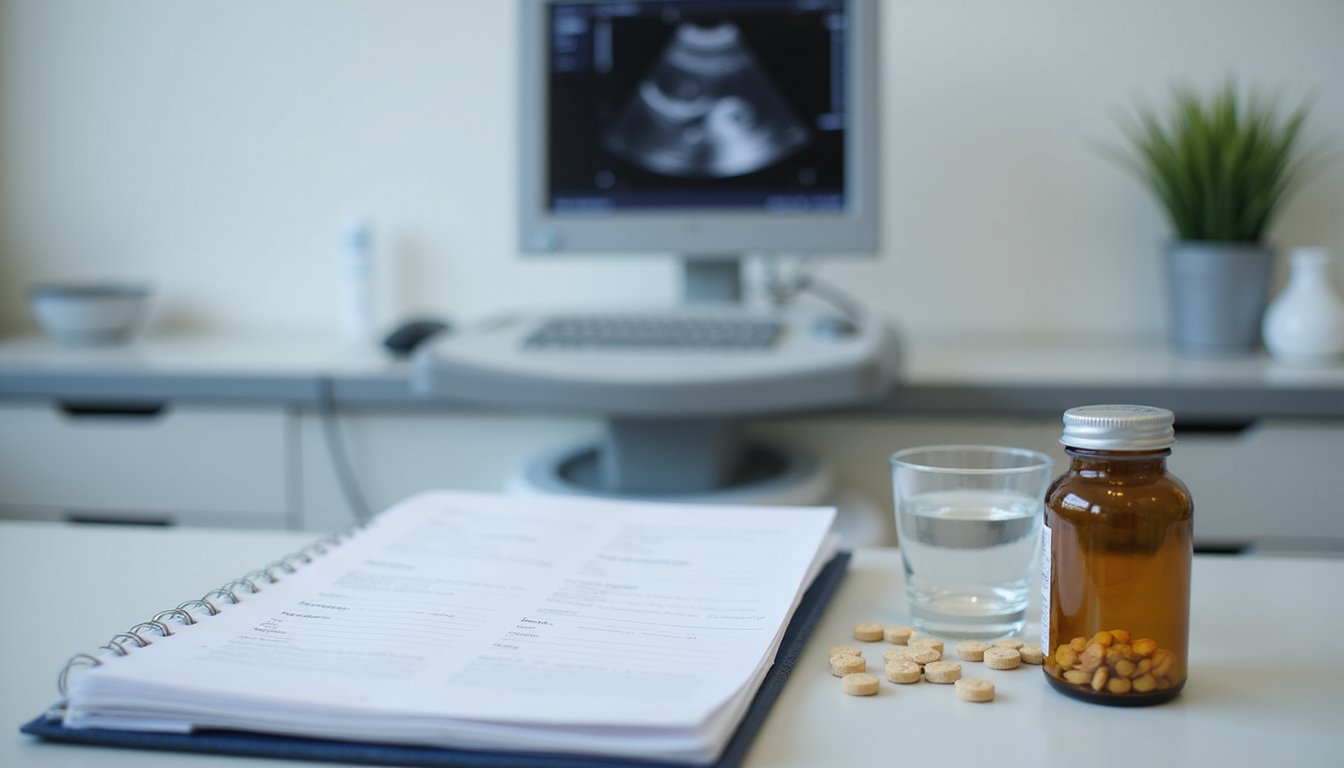If you’re pregnant and using Suboxone, you’ll need careful medical supervision throughout your treatment. Your doctor will establish proper dosing through careful titration, typically starting at 8mg sublingual buprenorphine with adjustments every 4-6 weeks as your metabolism changes. You’ll require regular monitoring, drug screening, and coordination between your obstetric and addiction treatment teams. Safe treatment involves inclusive protocols, and understanding the full scope of care can help confirm favorable results for both you and your baby.
Understanding Suboxone and Pregnancy Safety

While Suboxone plays an essential role in treating opioid use disorder, its use during pregnancy requires careful consideration of both maternal and fetal risks. Current evidence suggests that Suboxone exposure results in better pregnancy outcomes compared to untreated opioid dependence, though maternal safety concerns persist regarding the naloxone component. Newborns may experience neonatal withdrawal syndrome with symptoms including irritability and trouble sleeping. Studies have shown that pregnant women receiving Suboxone treatment are less likely hospitalized during their pregnancy.
Healthcare providers typically recommend switching to buprenorphine-only formulations during pregnancy to minimize potential neonatal withdrawal risks. The recommended approach emphasizes early universal screening to identify and properly manage opioid use during pregnancy. While Suboxone-exposed infants may experience withdrawal symptoms, these cases are generally less severe than those associated with heroin exposure.
The CDC and ASAM guidelines support continuing medication-assisted treatment throughout pregnancy, as the risks of untreated opioid use disorder greatly outweigh the managed risks of Suboxone or buprenorphine treatment.
Key Benefits of Medication-Assisted Treatment
The integration of medication-assisted treatment (MAT) offers substantial, evidence-based benefits for patients managing opioid use disorder during pregnancy. You’ll experience greatly reduced health risks, including lower rates of overdose and decreased transmission of infectious diseases. MAT’s comprehensive approach combines FDA-approved medications with behavioral interventions, leading to improved treatment retention and reduced stigma perceptions.
Through controlled withdrawal management, you’ll find relief from severe detoxification symptoms while maintaining stability in your recovery journey. The use of FDA-approved medications helps normalize body chemistry throughout the treatment process. MAT’s evidence-based framework supports improved family dynamics and enhanced social functioning, allowing you to focus on your health and pregnancy. The treatment protocol’s wraparound services address both physical and psychological aspects of recovery, while medical supervision protects your safety throughout the process. This integrated approach remarkably improves maternal and fetal health outcomes.
Proper Dosing Guidelines During Each Trimester

During the first trimester, you’ll need to establish initial stabilization through careful dose titration starting at 2-4 mg, with close monitoring over 60-90 minutes to assess withdrawal symptoms.
As you progress through pregnancy, expect to increase dosing frequency to every 12 hours due to accelerated metabolism, particularly after entering the third trimester when physiological demands peak.
You’ll typically need to adjust doses upward during later trimesters to maintain therapeutic levels, requiring regular reassessment every 4-6 weeks to accommodate your changing metabolic needs.
First Trimester Stabilization Protocol
Establishing proper stabilization protocols in first-trimester pregnancy requires careful attention to buprenorphine dosing and monitoring strategies. You’ll need to move to monotherapy (Subutex) from combination products, maintaining the same initial dose before making adjustments. About 70% of previously stable patients will require modest dose increases of 3-5mg throughout gestation. Weekly urine tests are required to monitor medication adherence and screen for other substance use.
Initial induction typically begins with 4mg buprenorphine, reduced to 2mg for non-dependent individuals. You’ll need to monitor patients closely for withdrawal symptoms, using the Clinical Opiate Withdrawal Scale (COWS) to guide dose adjustments. Weekly assessments help determine if dose modifications are necessary.
When managing withdrawal symptoms, gradual dose escalation after Day 4 helps prevent precipitated withdrawal while ensuring patient comfort and stability.
Managing Third Trimester Increases
As pregnancy progresses into later stages, proper management of buprenorphine dosing becomes increasingly complex due to physiological changes affecting medication metabolism. Implementing gradual dose optimization during the third trimester requires careful attention to withdrawal mitigation strategies while maintaining therapeutic levels.
You’ll need more frequent dosing intervals (3-4 times daily) to maintain plasma levels above 1 ng/mL, with target maintenance doses averaging 16mg
Your healthcare team will monitor withdrawal symptoms weekly, adjusting doses to prevent complications while avoiding sudden changes
You’ll require coordination between your obstetric and addiction care providers to safeguard seamless delivery planning
You should expect proactive dose increases based on blood volume changes, with adjunctive therapies like clonidine available to manage symptoms without excessive dose escalation
Managing the Induction Process Safely
Safe induction of Suboxone requires careful timing and systematic assessment of pregnant patients to minimize risks to both mother and fetus. You’ll need to wait 3-5 half-lives after the last opioid use and confirm moderate withdrawal symptoms with a COWS score of ≥8 before initiating treatment.
Prior to induction, complete a thorough medication reconciliation and verify treatment adherence through toxicology screening and prescription monitoring. For patients beyond 23 weeks gestation or with complicated medical histories, you must conduct induction in an inpatient setting.
Start with 8mg sublingual buprenorphine, monitoring closely for precipitated withdrawal. If needed, implement split dosing, particularly in later pregnancy stages. Don’t attempt induction during acute medical crises or active polysubstance use, and maintain consistent dosing throughout pregnancy to prevent relapse risks.
Monitoring and Treatment Protocol Adherence

Three core components drive successful Suboxone treatment monitoring during pregnancy: regular assessment of withdrawal symptoms, verification of medication adherence, and coordination between providers. You’ll need to participate in routine medication adherence reviews and ongoing substance use monitoring throughout your pregnancy to guarantee optimal outcomes.
Effective Suboxone treatment during pregnancy requires symptom monitoring, medication compliance checks, and seamless coordination across healthcare providers.
Your treatment protocol includes:
- Weekly evaluations to assess withdrawal symptoms and adjust treatment as needed
- Regular urine drug screens and pill counts to verify proper medication use
- Structured obstetric visits following a specific schedule based on gestational age
- Cross-provider communication to maintain coordinated care between your obstetric and addiction treatment teams
Maintaining compliance with these monitoring requirements helps guarantee your safety and supports positive treatment outcomes. Your healthcare team will document all monitoring activities in your medical record and adjust protocols based on individual needs.
Labor and Delivery Pain Management Strategies
Effective pain management during labor requires careful coordination of your maintenance medication with additional analgesic strategies. You’ll need to continue your regular buprenorphine dosing throughout labor to prevent withdrawal complications. Your healthcare team will likely recommend epidural analgesia as the primary supplemental analgesia option, combining it with scheduled NSAIDs for supreme pain control. Since buprenorphine has a high binding affinity to opioid receptors, standard opioid medications may be less effective for breakthrough pain.
Risk mitigation strategies include dividing your daily medication into more frequent doses and avoiding any pre-labor tapering. You’ll have access to patient-controlled epidural dosing to help manage breakthrough pain. Your medical team will monitor you closely for signs of withdrawal, including blood pressure changes and elevated heart rate. They’ll coordinate with your addiction treatment provider to maintain appropriate dosing while protecting both you and your baby during delivery.
Postpartum Care and Recovery Support
Recovering from childbirth while maintaining medication-assisted treatment requires detailed postpartum support and careful monitoring. Your healthcare team will focus on lifelong medication continuity and community reintegration planning to guarantee your successful recovery. You’ll receive comprehensive care that addresses both your medical and psychosocial needs.
Key aspects of your postpartum care include:
- Maintaining your pre-delivery MOUD dosage unless sedation occurs
- Integrating non-opioid pain management strategies with your existing treatment
- Accessing wrap-around services for housing, childcare, and mental health support
- Connecting with peer recovery networks and lactation specialists
The risk of relapse significantly increases during the postpartum period, making sustained support crucial for maintaining recovery. You’ll attend frequent follow-up appointments initially, which will be adjusted based on your stability. Remember, continuing MOUD indefinitely is a valid option, and any medication changes should only occur under strict medical supervision when you and your infant are stable.
Breastfeeding Considerations and Guidelines
If you’re breastfeeding while taking Suboxone, you’ll need to carefully monitor your infant for signs of sleepiness, breathing changes, and proper weight gain. Your healthcare provider should determine appropriate dosing that balances your treatment needs with minimizing medication transfer through breast milk.
You mustn’t stop Suboxone suddenly while nursing, as this could trigger withdrawal symptoms in both you and your infant, including nausea, diarrhea, and irritability. Only small amounts pass into breast milk during treatment, but it’s still important to watch for any unusual symptoms in your baby. Breastfeeding your baby can help reduce the severity of withdrawal symptoms and decrease hospital stays compared to formula-fed infants. Speaking with your doctor about potential alternatives to Suboxone that may be safer during nursing is an important step in developing your treatment plan.
Medication Transfer Through Milk
The transfer of buprenorphine through breast milk presents minimal risks to nursing infants, with studies consistently showing negligible exposure levels. When you’re breastfeeding while on Suboxone, you’ll find reassurance in knowing that relative infant dose remains below 1% of maternal dosing.
For minimizing risk of exposure and ensuring long-term infant monitoring, consider these key points:
- Use the lowest effective dose of buprenorphine that maintains your stability
- Monitor your infant for signs of drowsiness or changes in feeding patterns
- Track your baby’s weight gain and development through regular pediatric visits
- Report any concerning symptoms like excessive sleepiness or breathing changes immediately
If dose adjustments become necessary, don’t make changes without medical supervision, as sudden medication changes can affect both you and your nursing infant.
Safe Dosing While Nursing
Successful breastfeeding while taking Suboxone requires careful attention to dosing schedules and safety protocols. You’ll need to maintain strict adherence to your prescribed dosage while implementing strategies for milk sharing during sedation periods. When experiencing medication-related drowsiness, pump breast milk for later use to guarantee your baby’s safety.
You must remain vigilant about managing oversedation risks by only nursing when fully alert. Monitor your infant for unusual sleepiness or feeding difficulties, and report any concerns to your healthcare team immediately. Work closely with your lactation consultant to develop a personalized feeding plan that accommodates your medication schedule. Continuing to breastfeed provides optimal nutrition and hydration for infants experiencing withdrawal symptoms.
Remember to stay hydrated, maintain proper nutrition, and keep detailed records of your baby’s feeding patterns. If unexpected sedation occurs, utilize your designated backup caregiver for alternative feeding methods.
Monitoring Infant Health
Monitoring your infant’s health while breastfeeding on Suboxone requires detailed clinical surveillance and systematic assessment protocols. You’ll need to work closely with your healthcare team to track developmental milestones and infant feeding patterns during this critical period.
Essential monitoring includes:
- Watching for signs of respiratory depression or unusual drowsiness during and after feeding sessions
- Tracking your baby’s weight gain to safeguard adequate nutrition and growth
- Observing feeding patterns and making necessary adjustments if your infant shows difficulty nursing
- Participating in developmental assessments to identify any potential delays
Since optimal care involves medication-assisted treatment, methadone or buprenorphine should be continued throughout the breastfeeding period under medical supervision. Consider rooming-in with your infant when possible, as this enhances your ability to respond to feeding cues and implement supportive care measures. Your healthcare provider will guide you through standardized assessment tools to preserve your baby’s health throughout the breastfeeding period. If your baby shows any unexplained symptoms, your doctor may recommend toxicology testing to ensure appropriate medical management.
Risks and Side Effects to Watch For
While Suboxone offers essential treatment for opioid use disorder during pregnancy, patients and healthcare providers must carefully monitor several potential risks and side effects.
You’ll need to watch for signs of fetal growth considerations, including potential restricted development and structural anomalies. Since buprenorphine crosses the placenta, even at low doses, your doctor will optimize your dosage carefully. You should be aware of possible maternal side effects, including nausea, constipation, headaches, and dizziness. The FDA category C classification indicates limited research on human subjects regarding safety during pregnancy.
There’s also an increased risk of complications like preeclampsia if treatment isn’t properly managed. Monitoring your liver function during treatment is essential, as there is a rare but serious risk of liver damage.
Your healthcare team will monitor your baby for potential neonatal abstinence syndrome (NAS), which can cause irritability, tremors, and feeding difficulties. While NAS from Suboxone is typically less severe than with other opioids, it still requires careful observation and management.
Coordinating Care Between Medical Providers
Effective coordination of your prenatal care requires seamless communication between multiple healthcare providers throughout your pregnancy. Through collaborative decision making and information transparency, your healthcare team will work together to guarantee thorough care for both you and your baby.
Your providers will establish:
- Regular case conferences between your obstetrician, addiction specialist, and other involved clinicians to monitor your progress
- Shared electronic health records to maintain accurate documentation of your medication history and treatment plans
- Pre-established protocols for managing your Suboxone treatment during pregnancy and delivery
- Clear handoff procedures between prenatal and postpartum care teams to prevent gaps in care
This coordinated approach helps maintain consistent treatment standards while allowing your providers to quickly address any concerns that arise during your pregnancy journey. Including medication-assisted treatment in your prenatal care plan helps reduce risks of complications like preterm birth and poor fetal growth.
Frequently Asked Questions
Can I Travel Internationally While Taking Suboxone During Pregnancy?
You can travel internationally while taking Suboxone, but you’ll need careful planning. Before making extended travel plans, consult your healthcare provider about medication dosage adjustments and documentation requirements.
Research your destination’s controlled substance laws, as some countries restrict or ban Suboxone. Carry your prescription, doctor’s letter, and original packaging. Consider destinations with reliable healthcare access and prepare for potential customs scrutiny during international travel.
How Do Insurance Companies Typically Cover Suboxone Treatment During Pregnancy?
Your medication coverage for Suboxone during pregnancy varies markedly between insurance types. If you’re on Medicaid, you’ll typically have broader coverage and fewer restrictions compared to commercial insurance.
You’ll need provider authorization in most cases, and your insurance may require prior approval or have specific dosage limits. It’s important to check with your insurance provider directly, as coverage policies can differ by state and plan type.
What Alternative Therapies Can Complement Suboxone Treatment During Pregnancy?
You can enhance your treatment outcomes by incorporating several evidence-based complementary therapies. Mindfulness-based interventions have shown promising results in reducing stress and managing cravings.
Prenatal yoga, when practiced under qualified instruction, may help with anxiety and physical discomfort. Additional beneficial therapies include cognitive behavioral therapy, group counseling, and meditation practices. Always consult your healthcare provider before starting any complementary therapy to verify it’s appropriate for your situation.
Should Partners or Family Members Receive Special Training for Emergencies?
Yes, you should guarantee your family support network receives emergency preparedness training. It’s essential that partners and family members learn to recognize overdose signs, administer naloxone, and understand proper emergency response protocols.
They’ll need training in medication safety practices, secure storage, and crisis management strategies. You should also make certain they know when to call 911 and how to document symptoms for healthcare providers. This knowledge can be life-saving during critical situations.
Are There Support Groups Specifically for Pregnant Women Using Suboxone?
Yes, you’ll find dedicated peer support programs designed specifically for pregnant women using Suboxone. Through programs like NOFAS Circle of Hope and MOMS integration, you can connect with others sharing similar experiences.
Professional-led prenatal counseling groups offer structured support while addressing your unique challenges. You’ll benefit from both the emotional support of peers and the clinical guidance of addiction specialists who understand your specific needs during pregnancy.

